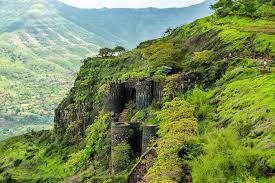Sinhagad Fort, located near Pune, Maharashtra, is one of the most famous forts in Indian history. Perched at an elevation of around 1,312 meters (4,305 feet) above sea level, this fort has played a important role in the history of the Maratha Empire. The name “Sinhagad” means “Lion’s Fort,” which symbolizes its strength and the bravery of the warriors who fought for it. This fort is most well-known for the Battle of Sinhagad in 1670, where the great Maratha warrior Tanaji Malusare sacrificed his life while recapturing the fort from the Mughals under the command of Chhatrapati Shivaji Maharaj. Even today, visitors can find a memorial dedicated to Tanaji Malusare at the fort, honoring his bravery.
The fort is not only a historic site but also a popular trekking and attracting thousands of tourists, history enthusiasts, and adventure lovers every year. Its breathtaking views, historic ruins, and connection with Maratha history make it a must-visit destination for anyone exploring Maharashtra’s heritage.
The Historical Significance of Sinhagad Fort
Sinhagad Fort has a rich history that dates back over 2,000 years. Originally known as Kondhana Fort. However, it gained historical importance during the rule of the Marathas. The most significant event in its history was the Battle of Sinhagad in 1670, fought between the Marathas and the Mughals. At that time, the fort was under Mughal control, and Chhatrapati Shivaji Maharaj wanted to reclaim it. He entrusted the mission to his loyal commander Tanaji Malusare, who led a daring night attack.
Tanaji Malusare and his men climbed the steep cliffs of the fort using ropes and launched a surprise attack. Though heavily outnumbered, they fought bravely, and Tanaji Malusare engaged in fierce combat with Udaybhan, the Mughal commander. Despite losing his life in the battle, Tanaji Malusare’s men continued fighting and eventually recaptured the fort. Upon hearing of Tanaji’s death, Shivaji Maharaj was deeply saddened and said, “Gad ala, pan Sinha gela” (We won the fort, but lost the lion), leading to the fort being renamed Sinhagad Fort. Over the years, the fort remained under Maratha control and played a strategic role in various battles.
Architecture and Key Attractions of Sinhagad Fort

Sinhagad Fort is an architectural marvel built on a rugged hilltop, making it a naturally strong defense structure. The fort’s thick walls, bastions, and steep cliffs made it nearly impossible for enemies to capture. The main entrance gates, Kalyan Darwaza and Pune Darwaza, still stand tall, showcasing Maratha architectural brilliance. Visitors can explore the Tanaji Malusare Memorial, built to honor the brave warrior who sacrificed his life in the battle. Another important spot is Rajaram’s Tomb, The tomb of Rajaram Maharaj, son of Shivaji Maharaj, is located at Sinhagad Fort, near Pune, Maharashtra, India. He died there on March 3, 1700, and is buried at the fort premises.
The Kondhaneshwar Temple, dedicated to Lord Shiva, is another attraction where devotees offer prayers. The fort also has cisterns, water tanks, and granaries, which were used to store food and water during wartime. One of the best experiences at Sinhagad Fort is the stunning panoramic view of the Sahyadri mountains and Pune city, especially during sunrise and sunset. During monsoon, the fort is covered in lush greenery, making it a paradise for nature lovers. Additionally, the fort is famous for its local food stalls serving traditional Maharashtrian snacks like Kanda Bhaji (onion fritters) and Pithla Bhakri (a spicy gram flour dish with bread), making the visit even more enjoyable.
Trekking and How to Reach Sinhagad Fort
Sinhagad Fort is a favorite trekking destination for adventure enthusiasts. The trek to the fort starts from the Sinhagad base village, which is about 2.5 km uphill and takes around 1.5 to 2 hours to complete. The trekking route passes through dense forests, rocky paths, and steep slopes, offering a thrilling experience. For those who prefer a shorter trek, there is a motorable road leading to the fort’s entrance, making it accessible for all age groups. The best time to visit Sinhagad Fort is during the monsoon (June to September) and winter (October to February) when the weather is pleasant and the surroundings are green.
The fort is approximately 35 km from Pune, and visitors can reach it by car, bike, or public transport. Local buses and shared taxis are available from Swargate Bus Stand in Pune to Sinhagad base. Guides are also available at the fort for those interested in learning more about its history. Sinhagad Fort remains a perfect blend of history, adventure, and nature, making it an unmissable attraction in Maharashtra. Whether you are a history buff, a trekking enthusiast, or simply someone who loves nature, a visit to Sinhagad Fort will leave you with unforgettable memories.

[…] significant historical places associated with him include Raigad Fort, Pratapgad Fort, Rajgad Fort, Sinhagad Fort, Torna Fort, Purandar Fort, Lohagad Fort, and Sindhudurg […]